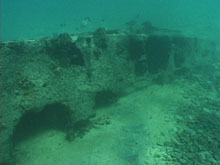NOWRAMP
2002
Shipwreck
Team Headed South
Posted by Dr. Hans Van Tilburg, Maritime Archaeology and
History Team Leader
October 3, 2002
 Today
we transit from Lisianski back to French Frigate Shoals.
Most of our target areas are to the north, so the bulk of
the field work is behind us. It's been an incredible experience.
We have had the opportunity to record the remains of 16
different known and unknown vessels, 14 separate anchors,
and two aircraft crash sites. These include steel fishing
vessels, navy ships, landing craft, merchant freighters,
bamboo rafts, World War II fighter planes, and large wooden
sailing ships from the 19th century. Many of these shipwrecks
are well preserved due to their isolation, and all open
a window on our maritime past in the Pacific.
Today
we transit from Lisianski back to French Frigate Shoals.
Most of our target areas are to the north, so the bulk of
the field work is behind us. It's been an incredible experience.
We have had the opportunity to record the remains of 16
different known and unknown vessels, 14 separate anchors,
and two aircraft crash sites. These include steel fishing
vessels, navy ships, landing craft, merchant freighters,
bamboo rafts, World War II fighter planes, and large wooden
sailing ships from the 19th century. Many of these shipwrecks
are well preserved due to their isolation, and all open
a window on our maritime past in the Pacific.
The
power of the ocean to reshape the wreck map is one of the
most impressive lessons from the cruise. Some of the larger
steel wrecks are simply not where they've been reported.
Others have had large heavy sections pushed around the lagoons
like toys. Prevailing wind and currents, storm frequency
and wave height, sedimentation rates and coral growth...all
of these are major environmental factors which affect site
formation processes for shipwrecks. Pieces of ships, whatever
their size, cannot be said to be permanent features of the
seascape. They may "wreck" once, twice, or three
times on different parts of the reef. In this sense, large
modern wrecks represent multiple threats to the environment.
The stern of the Houei Maru (wrecked in 1976) is
the best example of this. It now lies miles from the remains
of the rest of the vessel; it wasn't there last year.
 On
the flip side of the coin, wreck sites provide multiple
habitat and substrate opportunities for marine flora and
fauna. They are artificial reefs of an unintentional nature.
Monk seals find refuge from sharks, small fish find refuge
from jacks, and certain algae seem to thrive in the iron-rich
areas adjacent to wrecks. Marine habitats, environmental
threats, or historical and archaeological sites...wreck
sites present multiple characteristics in relationship to
the environment and resource management. The NOWRAMP cruise
represents one of the rare times that these kinds of sites
have been granted official recognition in this state.
On
the flip side of the coin, wreck sites provide multiple
habitat and substrate opportunities for marine flora and
fauna. They are artificial reefs of an unintentional nature.
Monk seals find refuge from sharks, small fish find refuge
from jacks, and certain algae seem to thrive in the iron-rich
areas adjacent to wrecks. Marine habitats, environmental
threats, or historical and archaeological sites...wreck
sites present multiple characteristics in relationship to
the environment and resource management. The NOWRAMP cruise
represents one of the rare times that these kinds of sites
have been granted official recognition in this state.
What
lies ahead? The summary report of the survey needs to be
completed. Data from the field needs to be cross-checked
with information from local archives, particularly for the
older wreck sites. Are we looking at the ship Gledstanes
which sank in 1837? The whaleship Parker in 1842?
Recommendations for the future management of submerged cultural
resources in the NWHI will be included in the report. One
of the special characteristics of these distant sites is
that they are unlooted, the physical record is much more
intact. Hopefully they will stay that way. This is something
almost unheard of for the known wreck sites in the Main
Hawaiian Islands, despite the protections
guaranteed by federal law.
 We
had only enough time to glimpse a portion of the more significant
wreck sites during this quick trip. The remains of the Carrollton
at Midway and the remains of the large unknown wooden ship
at Kure are just the tips of the iceberg, so to speak. These
are a couple of the older and more intriguing targets. Much
more lies beneath the sands, and sites like these warrant
more intensive investigation.
We
had only enough time to glimpse a portion of the more significant
wreck sites during this quick trip. The remains of the Carrollton
at Midway and the remains of the large unknown wooden ship
at Kure are just the tips of the iceberg, so to speak. These
are a couple of the older and more intriguing targets. Much
more lies beneath the sands, and sites like these warrant
more intensive investigation.
Who
will be available to carry this out? It remains to be seen
if there will be a local agency or academic program that
will continue this kind of research in Hawai‘i. Certainly
there is abundant opportunity in our nearshore waters. The
Hawaiian Islands are an ideal setting for underwater exploration
and discovery. Anyone interested in becoming part of this
new field in the Pacific should contact the shipwreck team
ASAP. Mahalo.
<<Journals
Home